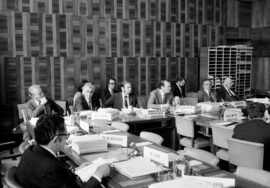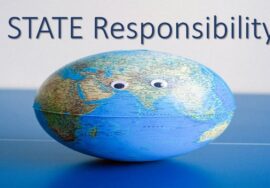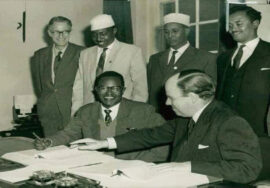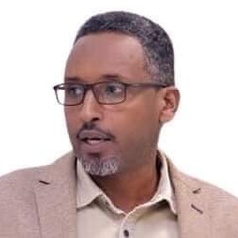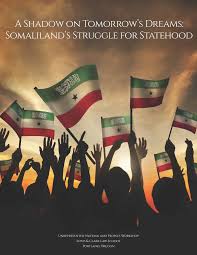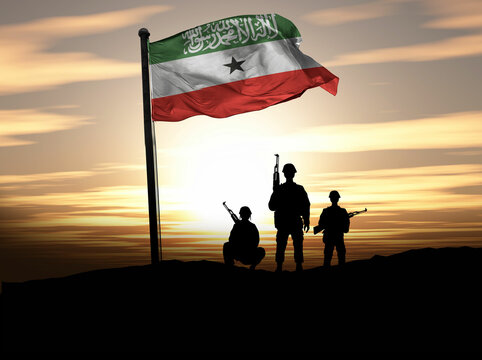
Counter-analysis of the paper of Ismael Laddaf
Counter-analysis of the paper of Ismael Laddaf
“The Somali Talks and the Somaliland Case”
1. Introduction: Author narration
Somaliland has an area of 137,600 km and a population estimated to be three-and -half million. The territory known as the British Protectorate of Somaliland was under the rule of Great Britain from 1884 to 26 June, 1960, when it became independent. The interest of the British in the territory was primarily to secure supply of meat for its garrison in Aden and to pre-empt ambitions of other competing Europeans powers such as the French and the Italians as well as the Ethiopian Emperor Menelik, who was also acquiring territories in the Somali region (ICG: 2003-2). The British secured its interest by signing treaties with local inhabitant clans including: Warsangeli, Dhulbahante, Isse, Gadabursi, Habar Garhajis, Habar Awal and Habar Tol J’lo (Lewis: 1965-35).
Incorrect Narrative: Four days after independence on 1st July 1960, Somaliland joined into a hasty and unconditional union with the newly independent Somalia, which was under Italian Trusteeship for the last ten years, and together formed the Somali Republic.
Corrected history: The narrative of an “unconditional union” is a Somalia perspective, not an accurate historical account. Somaliland and Somalia each passed a union act, but neither would sign the other’s version. Secondly, while not joining, Somaliland’s annexation by Somalia was illegal, lacking an international treaty to legitimize the union. Somaliland remains de jure independent since 26th June 1960, and liberated its territory on 18th May 1991..
Author narration: Somali Republic, after a decade of teetering democratic trials, was taken over by the army through a bloodless coup in 1969. Somalis then went through twenty years of centralized authoritarian military rule characterized by upheavals such as the disastrous war with Ethiopia in 1977 and the emergence of three armed opposition movements (the Somali National Movement, SNM; Somali Salvation Democratic Front –SSDF; and United Somali Congress –USC).
SNM enjoyed the support of the majority of the population in the ex-British Protectorate of Somaliland. It waged a guerrilla war against the government forces and eventually captured the whole territory from Siyad Barre’s forces in January 1991. SNM oversaw the reclamation of Somaliland independence in a Grand Clan-Conference in Burao on 18 May, 1991 and was mandated to rule for a two-year transitional period. Its two-year rule was characterized by internal turmoil within SNM ranks and the proliferation of clan militia influences (Jimcaale: APD 2005). However, during this short period the SNM administration was also able to oversee unprecedented process of dialogue and reconciliation among the Somaliland beelo (clans and sub-clans), before it turned over the power to a civilian government in 1993 at the Grand Borame Conference. Since 1991, Somaliland has succeeded to go through a successful path of social, political, and economic reconstruction. This reconstruction process is often characterized as essentially home-grown.
2. The 1960 Union and the Somaliland feeling of betrayal: This goes beyond betrayal and it was illegal union and still is.
Author Narration: The 1960 union was kind of a sellout deal for the Somaliland people. There were three core weaknesses on the side of the Somaliland party:
1. There was no clear strategy for a negotiated agreement. An ad-hoc team was put together from Hargeisa, who were already in a festive mood to bring the two Somali states together and had even prepared in advance the union songs, music and drama. They had no clear object or idea of how a union of two disparate states will look like and in this regard had no support from the colonial office or state.
2. They did not work out a viable BATNA – your “best alternative to a negotiated settlement”. It is very important in any negotiation to have your alternative route to go if the negotiations fail, and the stronger your BATNA1 the more you can realize your interests and objectives in the negotiations. In 1960, the Somaliland leaders failed to prepare against the perils of a hasty union and hence, went to Mogadishu without an exit strategy if they were not satisfied with the results of negotiations and ended up in a situation of total sell out.
3. The other party was much more advanced in the business of state management and was also more steeped in clan political power relations. Somalia was under the AFIS already for ten years, being prepared for independence and its elite were ready to take the reign of their new state, while from newly independent Somaliland state, a negligible percentage of the bureaucracy and political elite had any significant senior management track records or political acumen or experience while going for the union. It became easily apparent to the other side their lack of experience and internal cohesion to be a serious negotiating party and hence took full advantage of the situation.
- Two decades of civil war: I reject this insinuation
Author narrative:This story has been told repeatedly for the last thirty-some years and still it haunts only the victims and their tormentors, hence, is worth retelling as long as there is a remote possibility of it being repeated.
Correct narration: As Somalilander, there is no civil war but Somalia illegal attack against Somaliland since 1980 and illegal occupation of Somaliland by so-called fascist illegal union of 1960s.
Author narrative: Some of the root causes of the conflict were: first a sense of betrayal in the union as mentioned above. Secondly, an early alienation from the military rule after the execution of the most senior member of the SRC from Isaaq and mass releases from civil service jobs of senior members from the North. Thirdly, the concentration of development resources in the south while the north was relegated to a periphery status in state development strategies and plans. And fourthly, the eventual subjection of the north to a harsh emergency rule which masked a cynic plan of neutralizing the dominance of one “rebellious” clan (Isaaq) through the influx of other clan groups, plundering of the wealth of this dominant clan and an eventual all-out war against it to the level of clan-cleansing.
Therefore, this is ultimately the story of human suffering in which victims are still alive and are to be found in all corners of the world and many of them constantly dreading the repeat of the same experience. That explains the reluctance of large sections of the Somaliland population to even think of relinquishing one ounce of their independent status even if the hope for recognition is not bearing fruit. Some of the human stories include:
THE UFO STORY: The twisting of the UFO group volunteer work into a crime against the state and their eventual incarceration for a decade in high security Labaatan Jirow prison, is still a living memory of blatant human rights’ violation against the group and for which no justice has been done yet.
THE STUDENT UPRISING: The rioting of school children during the same period and the state response of killing and jailing of many of these children is also a living memory in the streets of Hargeisa and in the homes of their parents if they themselves survived from war.
THE JAZIRA BEACH MASSACRE: The massacre of over forty intellectuals in Mogadishu southern beach under the noses of the international community in 1989 is also alive in the psyche of all Somalis and no justice has been done yet.
THE MASSACRE OF BURAO ELDERS: The forty elders and businessmen subjected to kangaroo courts and executed in broad daylight, in the presence of their loved ones and the larger population of Burao still haunts the population of that city.
All these cohorts of people killed or incarcerated were all civilians, who had no military connection but simply belonged to the same clan family group and in most cases were not politically active. For all these and more, no justice has been done so far and worse still rendering justice for all those atrocities are in no one’s agenda. The usual story goes that so many other gruesome atrocities happened afterwards in Somalia and even to the perpetrators. But these were crimes willfully committed by state machinery and are different from clans killing each other and with comparable force levels.
The above tragic episodes are only examples of the abuse of state power in two decades of military occupational rule and curtailment of human and civil rights in Northern Somalia. Furthermore, these cited examples were only a prelude to the genocidal war waged by the state against its own people in 1988-1991, which was comparable to war crimes which happened in other parts of the world and for which international courts are formed. The fifty thousand dead in the international records is quite an underestimation for lack of serious research; mass eviction of the populations across the border to suffer years in refugees camps in the wilderness of the eastern Ethiopian Somali region; the total destruction of their cities and centuries of their accumulated wealth and heritage; the statelessness and suffering in diasporic life in all corners of the world are all under-recorded and unattended to issues.
The British, in the fight against the Sayyid Mohamed Abdulle Hassan’s rebellion in the Somaliland 1911 – 1920, used aerial bombardments in a desperate attempt to conclude the war – this went down in the annuls of history as the first time airplanes are employed in an African war. Similarly, airplanes herding people through aerial bombardment to cross the state borders has not been recorded in history except when Siyad Barre’s employment of South African mercenary pilots against the displaced civilians in Somaliland. An estimated population of 1.2 million was forced to cross the border in this fashion to Ethiopian Somali region in 1988.
Therefore, in the Somaliland case, it is not going to be easy to coax people who are still nursing their open wounds inflicted by the Government in Mogadishu and their national army, to open
their hearts and minds to return to a political association with Somalia. On the contrary, the Somaliland people in fact made sure that their leaders won’t have it easy to bypass them to enter into agreements with their counterparts in Mogadishu, by tying them with a robust Constitution and layers of legal instruments and also by remaining vigilant and alert lest they are bound into an unholy marriage again.
- State Collapse and Rebirth of Somaliland:
During the first ten years of the union, Somalilanders tried to cope with the situation first to tap into their rich oral literature, in which the literary giants produced a series of popular dramas which reflected peoples’ worries on their exclusion and alienation from the power of Somalia; and secondly through their entrepreneurial tradition primarily based on the livestock trade and their trading culture. Their elite had an edge through their more advanced educational and bureaucratic systems to fend for themselves in the nepotism infested civil service jobs and scholarship markets in Mogadishu. After the military takeover of power, the prejudice against Somalilanders became the official policy of the state, which translated into a systematic exclusion permeating all aspects of state functions, and eventually the Isaaq clan-family was singled out as main target of the exclusion. The rulers first translated the inevitable trial of the excluded to protest and fend for themselves as a rejection of the state authority, so their exclusion turned into oppression. Eventually the people rebelled, and some sectors of their elite including army officers formed SNM, which gave the regime the excuse it was looking for, and it tried with all its state might to crush the clan and its fledgling organization, but ultimately after a decade of war, the fire spread to Mogadishu. The regime lost the war, the state collapsed in January 1991, Somaliland reclaimed its independence on May 18, 1991 and Somalia is still struggling to form a coherent state system.
- The status quo today – twenty-some years of separate development
Please Stop making everything was perfect in Somalia in 1960s: The reality on the ground today is very much different from the eve of the union in 1960. Somalia was a functioning state with a robust government and vibrant political system.
I reject the author narration: Somaliland was an infant state just emerging from eighty years of foreign rule with no experience whatsoever of how to run a state. It melted into the Italian influenced state and the British Government washed its hands of its troublesome baby and left it to the wolves.
However, the two states have changed positions when it comes to existence of functioning institutions: a vibrant and healthy democratic political system and a very liberated population in Somaliland while the Somalia state is far from functioning, is dependent on foreign forces for its existence, and is still teetering under the burden of layers of anti-state forces, with some of the sinister ones lurking in the shadows and others openly defying any central rule. The Federal dream Somalia is pursuing would not be any different from the 1960 dream of a greater Somalia, if not grounded on the present realities in the region.
Correct narration: The accurate account is that Somaliland is not a new infant in the 1960s; it has a longer history as a state than Somalia, achieving independence 5 days before Somalia. Secondly, like many African nations post-1960s decolonisation, Somaliland lacked governance experience; however, Somalia’s expansionist ideology uniquely promoted territorial aggression through deceit and dishonesty. Somalia refused to recognise Somaliland’s sovereignty, a mindset inherited from their Italian colonial rulers. Therefore, a 1960s-style federation between Somaliland and Somalia is impossible given that your model of federalism applies to internal regions, not independent states.
Author narration: Furthermore, the two Somali states have been going through two different and divergent trajectories of development in the last twenty-some years. Somalia became the problem child of IGADD and the Arab League first and eventually that of the whole world. It excelled in the production of warlord culture, it reincarnated the pirate economy which in the rest of the world was considered alive only in the movie stories, it produced the most virulent version of al-Qaida offshoots the “AL Shabaab”; it splintered into state-lets resembling the feudal Europe; it spawned an unregulated economic boom which even captured established markets in East and Central Africa, and its population became famous in all continents as people that can eke out a living from any environment in the world and excel even the indigenous. However, its worst aspect, though, is the resilience of these forces to resist the rule of law and the right of legitimate force of the state, and the fact that no other party is entitled to that privilege.
There is continued economic interaction and free flow of people: Livestock economy still remains to be the most important economic activity and source of employment and sustenance for the population of all Somali territories in the Horn of Africa region. Berbera remains to command the lead role as an external access to the exports of that resource and primarily to the Hajj season in Saudi Arabia, as well as the wider Arabian Gulf region. The interaction of the business people of Somalia and Somaliland, and the flow of goods and services continues to flourish, especially in the interregional service sectors such as the telecommunication, the money transfer economy, the airline industry, and the livestock export system.
Reject this narration: Similarly, the flow of population movements and settlements continued to fluctuate since inter- clan strife declined in the last decade. When the civil war intensified in the Somalia and therefore their populations, especially from Mogadishu, fleeing from the war continue to be welcomed in other more settled regions and states such as Somaliland and Puntland. The displaced population is allowed to lead a normal life in Somaliland cities, to trade and to avail themselves the already constrained public services without state sanctioned discrimination or restrictions.
Please stop referring to Somaliland as a region of Somalia, as Puntland is a regional part of Somalia. Second, eighty percent of Somalis fleeing their civil war end up in Kenya and Ethiopia. Although I am not affiliated with the Somaliland government, I oppose any Somalian entering Somaliland, whether now or in the future. This isn’t an emotional outburst; it’s strategic thinking. My distrust of them goes back 65 years.
- Should Somaliland Negotiate with Somalia: About what? Are you kidding?
Author narration: The Somaliland Parliament has passed a resolution, which states “it is allowed to seek the Somaliland interest from anywhere and any group deemed necessary for that purpose”. It has to be clear though, that it is enshrined in the Somaliland Constitution that national sovereignty is sacrosanct. Therefore, the bottom line of Somaliland’s international negotiations is to secure international recognition for Somaliland. However, there are modalities that the international community followed when it comes to deal with deep conflict situations where a straightforward cohabitation of the two parties to continue under one sovereign state becomes untenable. These modalities revolve around creating a climate where the opposing forces can negotiate a divorce or a new arrangement for political association. In the Somalia context, we are facing a unique situation where the central state has collapsed and other entities emerged, some at the capital region who consider themselves as repositories of the sovereignty and others in the periphery and as independent states as in Somaliland. It seems that the easiest route the international actors see is one Somalia state, which should come through negotiations on a power sharing formula and preferably in a federal form. However, if there is going to be a separation, it has to also come from a process of negotiations. But Somaliland reclaimed its independence unilaterally. Therefore, the first challenge for Somaliland is how to reconcile negotiations with its unilateral reclamation of independence, as enshrined in its constitution. Although there is no incentive for Somalilanders to dismantle their hard-won achievements for last twenty-some years, it is still imperative for them to negotiate to achieve their ultimate objective – international recognition.
The initial 2012 discussions caused a dilemma regarding Somaliland’s recognition as the Republic of Somaliland.
1. Through negotiations with Somalia, Somaliland transformed into a separatist region, effectively pursuing self-determination, which was granted by Great Britain on June 26, 1960.
2. By engaging in discussions with Somalia, the “parent-state” effectively rendered the recognition of the Republic of Somaliland by the UK in the 1960s ineffective or null.
3. Somaliland’s actions are not one-sided; their independence predates Somalia’s, stemming from Great Britain, not from the 1991 event, which was a reclamation of their 1960s independence and a rejection of an initially illegitimate union.
4. During the period 1960-1991, Somaliland’s independence was violated by an illegal occupation from Somalia.
5. In Somaliland’s view, Somalia’s collapse in 1991 renders it unequal. The saga of Italian Somalia being wiped out by nature’s control. Somaliland has no need to communicate with a defunct state; its actions are not unilateral. That’s a fact!
6. The international community needs to consider returning Somalia to Zanzibar, Kenya, or Ethiopia. Somaliland inherited the remaining British Protectorate borders in the Horn of Africa. Full stop!
7. Somaliland must end dialogue with Somalia’s failed state. (Somalia is Zombie-State)
- Preparing for Negotiations
Somaliland Clarifying its Interests and Aspirations i. Safety and security of the individual and the population:
- The Somali population is a clan society. The Somaliland clans have a heritage and structured tradition of settling conflicts and protection under the law (Xeer). On the bases of that tradition, the clans indigenous to Somaliland were able to establish a state that guarantees the safety and security of all clan members. On the contrary, the majority of the population believes that a Mogadishu centered state will be under the dominion of the southern clans and since there is no tradition of a binding Xeer with these clans, they cannot trust it with their safety and security. Counter-Analysis: The idea of Somaliland uniting with Somalia is laughable; it’s not even being considered.
- The Somaliland population, especially the majority Isaaq does not trust their safety and security to Somalia authority and state. This population considers the experience of the civil war, which had all the ingredients of “clan-cleansing” as a proof of their distrust to a central Somali state. Counter-Analysis: The genocide, akin to “a nail in the coffin,” sealed the fate of the illegal Somalia union; do you understand this? That surpasses mere trust, security, and safety. Somalia is beyond repair in terms of managing the sentiments of the Somaliland population.
- Recognition: Referring to Somaliland as “the North” is inaccurate and offensive. Imagine someone misnaming you—that’s how it feels. You’re belittling Somaliland’s independence declared on 26th June 1960.
- With their own state, Somalilanders will have their fate and future in their own hands: they would not compete with the larger Somalia population for opportunities such as economic and development resources, as well as governance and public services. In the union, the development imbalance in the Somali sate between the North (Somaliland) and Somalia is well documented. Somaliland became a backyard and a periphery of development and its people became second- class citizens for a sate so much embroiled in southern politics. Counter-analysis: The issues between Somaliland and Somalia isn’t economic or governance. As author you overlooking or making a complex situation seem much simpler than it truly is. I’m saying you are not fully grasping the gravity or scope of the problems at hand.
- Somalilanders believe that Mogadishu is too far from their home-base and as happened before will become the hub of development and the power center of any central state, federal or otherwise and hence should not fall into that trap again. The Somaliland state, even
unrecognized, is growing into a mature polity, which serves the interests of its own populations and with a culture of mediation rather than control.
- Governance:
a) The Somaliland people have toiled to establish peace and security and a democratic system of governance for over two decades. They are moving on an ascending trajectory, however incremental, of improving their systems and institutions of governance. Somalia has just started on that trajectory, twenty or so years behind, and is now where Somaliland was in 1991. There is no easy way of integrating the two state cultures. There are two experiences which one needs to site: In 1960, the two states were coming together from different colonial backgrounds, with differing laws and state cultures. While the two states had some areas to complement each other, their differences were also glaring. Integrating them in an equitable manner became a nightmare; hence, the southern Italian system was adopted to dominate the new Republic’s governance system and culture. Today, the Somaliland state system is working and is more advanced than that of Somalia, but anecdotally, the Somalilanders do not envisage that the southerners recognize that and that they are not disposed to compromise, but rather that their culture is steeped in the principle “cadyahow ama ku cunay am ku ciideeyey” which translates into “I will eat the pie in its entirety or throw it in the dust” – in nutshell, it is not a culture of sharing especially in power matters.
- Somaliland separation gets justification from Djibouti’s independent status. The Somaliland – Somalia union was based on the realization of a dream of uniting all Somali territories under one flag. However, Djibouti, which had the opportunity to join the union when it became independent in 1976, went its own way. Furthermore, the British did not honour the NFD referendum results of 1963 and the Ogaden continues to be further consolidated as the Ethiopian Somali region and is consolidating its identity and new development vision. Therefore, there is no compelling obligation for Somaliland to go back into a union, getting out of which cost it so dearly.
Counter-Analysis: The “Great Somalia” narrative is a well-known historical falsehood peddled to Somaliland politicians and its pastoralist communities. A Great-Somalia ambition never existed. The aim was to seize Somaliland and its people without resistance. Some claimed it was a British or Italian ploy, yet whoever orchestrated it, it remains history’s most masterful land grab.
- Social
Socially, the two states have grown apart. The Somaliland youth, which form over 70% of the population, know Somalia only as the state that perpetrated untold atrocities to its people and is trying to destroy their new democratic state again. It would be a hard sell to sway them and especially since they are the strongest voting power in Somaliland. No political party can afford to alienate them.
- Somaliland Separation from the Perspective of Somalia’s Population?
- Cudud – Loss of state power and might. The Somalia state without Somaliland will be a weaker and more vulnerable state against its regional competitors: Ethiopia and Kenya. Furthermore, differing Somali interests may arise to exploit the untapped resources of the region with possible emergence of antagonistic Somali alliances with other nations. Counter-Analysis: The Somali government’s promotion of another scam is meant to subdue its people against a perceived enemy. Somaliland’s recognition is the current focus of Somalia…
- Centrifugal syndrome: it will open the way for other Somalia sectors to separate. Somaliland separation could open the way for the possibility of further fragmentation of Somalia. It will diminish status of Mogadishu as the Somali power hub. Counter-Analysis: Somaliland’s population and politicians wouldn’t be concerned if Somalia were completely destroyed. Somaliland’s international recognition is being held hostage. Somalia doesn’t comprehend, do they? Somalia’s future is neither Somaliland’s responsibility nor its concern..
- Loss of economic opportunities such as the unhindered access to the important Port of Berbera; Somaliland is closer to Yemen and to Saudi Arabia, both critical export markets of livestock.
- There is no logic for separation, all Somalis suffered in the civil war and they can build a better future together again; besides, there are clans in Somaliland which still support Somali unity. Counter-Analysis: the author show clear Somalia allegiance and not Somaliland. HE IS EITHER INTERNAL ENEMY OR Somalian citizens who wrote about Somaliland history
Possible scenarios for the negotiations process:
This is a joke Scenario One: Negotiation for Mutual Separation
- Separation but cooperation on security, environment, economy and social milieus
- Reconciliation and reparations for the loss of life and material inflicted by the Somali State.
- Return or assurance of private property claims in both sides
- Division of all commonly owned properties between two states: Diplomatic and external commercial properties
- Delineation of the sea territories
- Sharing of international debts – what percent is Somaliland liable to?
Scenario Two: Negotiations for a transitional state –a time-bound re-association: HA HA HA
- Return to the 1960 situation: two independent states at negotiating table (which never was).
- It involves power sharing and resource sharing protocols
- The term of association should not be longer than 6 years as in Sudan
- The time is set to end with a referendum for Somaliland people to decide on one question: to go for independence or for Federation.
- The negotiations are internationally sponsored and sanctioned by UN and regional organizations such as the AU and the Arab League.
Scenario Three: continued deadlock : Somaliland is fighting against a zombie-state…period!
This will be a no-war no-peace situation and shall put both entities and populations at a disadvantageous position. For many sectors of Somalia population, lack of international recognition for Somaliland may look like a possible sign of ending its quest for separation. However, that is not a realistic vision; Somaliland unrecognized as it is, is serving its population relatively well as a governance model, and therefore, there is no reason why it should not continue to do so. In short, there is no obvious better alternative to it. Somalia, Federal or otherwise, has still a long way to prove its capacity to function as a unit. A minimum requirement for that is a nationally elected government, which is a step further than the current clan-based 4.5 selection status.



